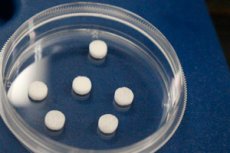New publications
Implantation sensors detect early signs of organ rejection in mice
Last reviewed: 02.07.2025

All iLive content is medically reviewed or fact checked to ensure as much factual accuracy as possible.
We have strict sourcing guidelines and only link to reputable media sites, academic research institutions and, whenever possible, medically peer reviewed studies. Note that the numbers in parentheses ([1], [2], etc.) are clickable links to these studies.
If you feel that any of our content is inaccurate, out-of-date, or otherwise questionable, please select it and press Ctrl + Enter.

A new study published in the journal Science Advances reports that the microporous scaffold functions as a minimally invasive surveillance method to detect rejection before graft failure in a mouse model.
These sensors are the first step toward creating a tool that could provide doctors with important early information about the potential for organ rejection in transplant patients.
Organ transplantation is accompanied by aggressive immunosuppression to prevent graft rejection. However, excessive immunosuppression can increase the risk of developing neoplasms and opportunistic infections, and insufficient immunosuppression can lead to graft damage.
Traditionally, transplant biopsies are performed to assess the effectiveness of immunosuppression. However, these invasive biopsies have significant variability and are a lagging indicator of rejection. To detect rejection before graft failure, a team of researchers from the University of Michigan used a microporous scaffold that functions as a minimally invasive monitoring method.
Following heart or skin transplantation in mice, niche implants accumulate innate and adaptive immune cells, and gene expression analyses identify biomarkers of acute cellular allograft rejection (ACAR) before clinical signs of graft failure occur.
Initial studies were performed with adoptive transfer of T cells into incompatible allografts, allowing a focus on T cell-mediated rejection, followed by validation studies in wild-type animals. The niche scaffold allows frequent cell sampling, and a panel of genetic biomarkers distinguishes mice that reject allografts from mice with healthy grafts.
"The study of monitoring immune responses has become exciting because of the rise of immunotherapies. This detection of an unwanted immune response has significant medical implications because often you don't know about an unwanted response until an organ starts to lose function," said Lonnie Shi, a professor of biomedical engineering at the University of Michigan and a co-author of the study.
The new process begins with implanting a porous scaffold under the skin, where tissue develops in the pores. The developing tissue becomes vascularized. The net effect is that blood vessels pass through this space, and immune cells circulate through them.
The material elicits a foreign body response, which leads to the recruitment of immune cells. Importantly, these cells exhibit a tissue-specific phenotype, not a circulating one, allowing researchers to monitor tissue responses over time.
"When the immune system is activated in the context of transplant rejection, you can see activated immune cells on the implant," Shi said.
The ability to assess immune responses in tissues could be a powerful tool for researchers studying the immune system. Serial analysis of cell transcriptomes could detect potential organ rejection with a minimally invasive biopsy instead of a higher-risk transplant biopsy.
"Solid organ graft survival is considered one of the most important achievements of modern medicine, yet we often overlook the aggressive therapies needed after transplantation to maintain healthy grafts," said Russell Urie, a postdoctoral fellow in the Department of Biomedical Engineering at the University of Michigan.
"These implantable sensors can detect very early rejection processes, which is a first step toward a tool for personalized post-transplant care and minimizing the invasive procedures and devastating side effects that transplant recipients currently have to endure," added Uri.
"This will be especially important for organ transplant recipients in childhood and adolescence, as they must undergo treatment and biopsies for several decades and even repeat transplants."
